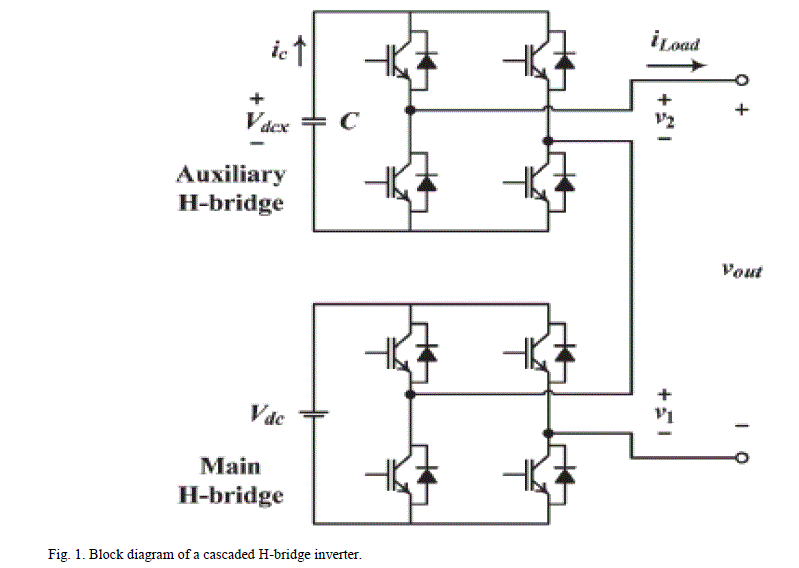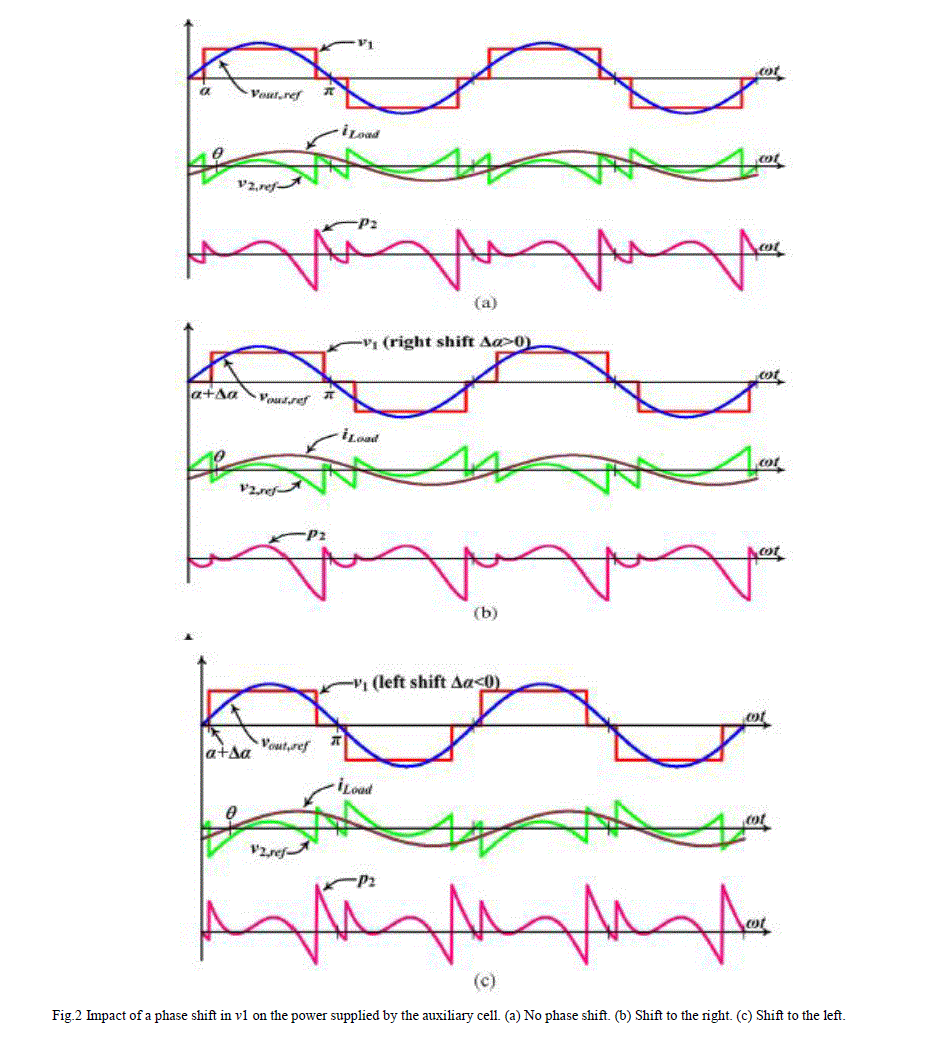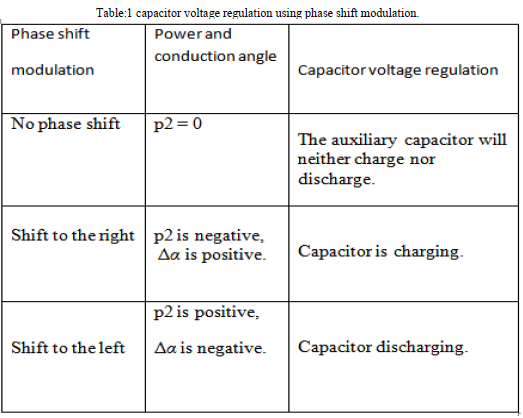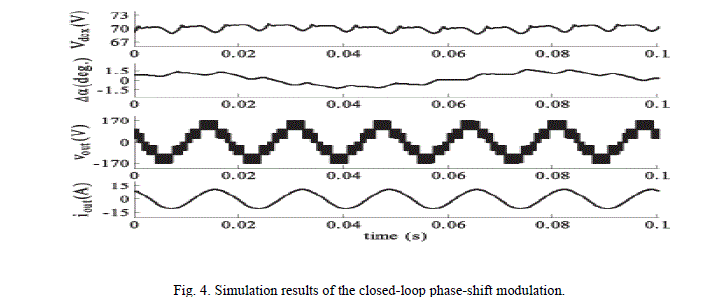ISSN ONLINE(2319-8753)PRINT(2347-6710)
ISSN ONLINE(2319-8753)PRINT(2347-6710)
K.Srilatha1, Prof. V.Bugga Rao2
|
| Related article at Pubmed, Scholar Google |
Visit for more related articles at International Journal of Innovative Research in Science, Engineering and Technology
This paper presents a new control technique to regulate the capacitor voltage in cascaded multilevel inverters. Without requiring transformers, the scheme proposed here allows the use of a single dc power source with the remaining n − 1 dc sources being capacitors, which can achieve an effective role on harmonic elimination while generating the ideal output voltage. This paper focuses mainly to achieve an effective capacitor voltage regulation, and the effect of power factor on capacitor voltage regulation with the Phase shift modulation. The main advantages of this paper are to eliminate the harmonics, high-quality output power due to its high number of output levels. It shows hope to reduce the voltage ripple of the capacitors, which leads to higher power conversion efficiency with equal power distribution, reduces the initial cost, and complexity hence it is apt for industrial applications. Simulation work is done using the MATLAB software and experimental results have been presented to validate the theory.
Keywords |
| Cascaded multilevel inverter, Capacitor voltage regulation, Phase shift modulation, Power factor, Power distribution. |
INTRODUCTION |
| In recent years, multilevel inverters have gained much attention in the application areas of medium voltage and high power owing to their various advantages such as lower common mode voltage, lower voltage stress on power switches, lower dv/dt ratio to supply lower harmonic contents in output voltage and current. Comparing two-level inverter topologies at the same power ratings, MLIs also have the advantages that the harmonic components of line-to-line voltages fed to load are reduced owing to its switching frequencies. The cascaded H-bridge multilevel converter has been applied to high-power and high-quality applications such as static volt-ampere reactive generation, active filters, reactive power compensators, photovoltaic power conversion, uninterruptible power supplies, and magnetic resonance imaging. Furthermore, one of the growing applications for multilevel power electronic converters is electric-drive vehicles in which the traction motor is driven by batteries. |
| A cascaded H-bridge multilevel inverter consists of several H-bridge cells connected in a series to form one phase of the converter. Each H-bridge cell generates a three-level output voltage and requires a separate dc voltage source. For multiphase converters several cascaded H-bridges are used and each cascaded H-bridge makes one leg of the converter. If each phase consists of more H-bridge units and each H-bridge cell is supplied with an isolated voltage source, it is possible, however to replace all of the dc voltage sources with capacitors but one of them. In this case, only one dc voltage source is needed for each phase of the converter. With this change the cost of converter decreases because a fewer number of isolated dc voltage sources are used especially when dc sources are supplied through ac/dc rectifiers. |
| However the voltage of the replacing capacitors must be regulated to a certain voltage in order to have the required voltage level in the output voltage of the converter. In this case, it is possible to use different modulation techniques, so that each cell of the converter can have different switching frequencies. For example, in a two cell converter, one of the H-bridge cells can be switched at the fundamental switching frequency (one turned on and off per switch per cycle) while another one can be switched with pulse width modulation (PWM) switching scheme, at a higher frequency. Doing so helps reduce switching losses, especially when, the voltage sources and the power ratings of the cells are unequal. |
CAPACITOR VOLTAGE REGULATION |
| In the proposed topology of H-bridge Cascaded multilevel inverter, the dc sources are replaced by capacitors. The replaced capacitors must be regulated to a certain voltage in order to have the required voltage level in the output voltage of the converter. However, the power system operation and modulation scheme together have different effects on each capacitor so that they are not charged and discharged evenly leading to different voltages in each leg of each phase. To achieve a high quality output voltage waveform, the voltages across all DC capacitors should maintain a constant value. |
| One challenging problem of the cascade multilevel inverter with a single DC source is the imbalance of the DC capacitor voltages. The imbalance is caused by: |
| 1) Different switching patterns for different H-bridges. |
| 2) Parameter variations of active and passive components inside H-bridges. |
| 3) Control resolution. |
| To achieve higher voltage quality, the switching patterns are usually different for different H-bridges in a phase. The differences of switching patterns mean that H-bridges cannot equally share the exchanged power with the power system. This causes uneven charging of DC capacitors. The parameter variations of components inherently cause different power losses of H-bridges. |
| The imbalance of DC capacitor voltages will degrade the quality of the voltage output. In severe cases, this could lead to the complete collapse of the power conversion system. Moreover, it will cause excessive voltages across the devices and an imbalance of switching losses. An adequate control strategy for avoiding the imbalance of DC capacitor voltages must meet the following requirements. |
| 1) The impact on voltage quality should be as small as possible. |
| 2) It can balance voltages when components of H-bridges have parameter variations. |
| 3) It can balance voltages when H-bridges switch with different switching patterns. |
| In the previous topologies, to balance the capacitor voltages, redundant state selection (RSS) is an effective tool in balancing the DC capacitor voltages. In this method the capacitor balancing is going to be achieved by using the proper capacitor in each level in order to get the desired level dictated by SPWM. In each level if the current direction of the phase is tending to charge the capacitors the least charged ones should be used to maintain the desired level and if the current direction tends to discharge the capacitors the most charged capacitors come into play. However, the output current of the inverter and the time duration of the redundant switching states greatly impact the charging or discharging patterns of the replacement capacitors [3], [6]. |
CAPACITOR VOLTAGE REGULATION USING PHASE SHIFT MODULATION |
| This paper proposes a control method applicable to single dc- source cascaded H bridge multilevel inverters to improve their capacitor voltage regulation. The proposed method, phase shift modulation, is robust and does not incur much computational burden. In this method, the main inverter switches at the fundamental frequency, and the auxiliary inverter switches at the PWM frequency. |
| Regulating the capacitor voltage in the auxiliary H-bridge cell is a challenging task. In the method proposed here, capacitor voltage regulation is achieved by adjusting the active power that the main H bridge cell injects into the system. By shifting the voltage waveform generated by the main H-bridge cell to the left or right, one can inject more (or less) active power, which can be used to charge (or discharge) the capacitor on the auxiliary cell. |
 |
| The main H-bridge cell, which is supplied by Vdc, generates a rectangular waveform (v1), the frequency of which equals that of the desired output voltage. Furthermore, the width of this rectangular waveform is chosen in such a way that the amplitude of its fundamental harmonic also equals that of the desired output voltage. In other words |
| Where α is the conduction angle of the main H-bridge cell |
| From the phase shift modulation of cascaded multilevel inverter, the real power flow capacitor voltages are balanced by adjusting the phase of the waveform, which we can observe in the following waveforms: |
 |
| Fig.2 Impact of a phase shift in v1 on the power supplied by the auxiliary cell. (a) No phase shift. (b) Shift to the right. (c) Shift to the left. |
| The operation of the capacitor voltage regulation using phase shift modulation is clearly explained by the table:1 shown below. From the table, when the capacitor is charging, the generated active power in the main cell will be greater than the power transferred to the load and the remaining power is used charge the capacitor of the auxiliary cell. |
 |
| While when the capacitor is discharging, the main cell will not supply as much power. Consequently, the capacitor in the auxiliary cell will be discharged. When no phase shifting is applied, the average power that the harmonics send out during a cycle is zero, which therefore does not contribute to the output power of the cell. Therefore, by controlling Δα we can charge or discharge the capacitor to regulate its voltage at the desired value. By using this method, capacitor voltage regulation is not possible for purely resistive load. Because, with resistive load, θ is zero, and p2 is always positive regardless of the value of Δα. Thus, charging the capacitor is not possible by changing Δα. In this proposed paper, the load is assumed to consist of a resistor in series with an inductor. |
EFFECT OF LOAD-POWERFACTOR ON REGULATION OF CAPACITOR VOLTAGE |
| In order to study capacitor voltage regulation a variable inductive load that changes in a wide range of power factor is used. For this reason a constant inductor with value of 0.1 H is connected with a variable resistance to obtain different power factors. Using simulation method, for each individual value of power factor the regulation of the capacitor is checked for the entire range of the modulation indices (m) and the maximum modulation index for each power factor is recorded. The results are depicted in Figure.3 According to this figure, capacitor voltage regulation is possible for every modulation index and power factor under the curve. When the load is more inductive (low power factor); the regulation region will extend to almost the entire region. However the power factor of most loads is above 0.7 where the capacitor voltage regulation region faces limitations. |
 |
| By the above analysis, this proposed method can effectively achieves the equal power distribution while maintaining equal charge and discharging periods using phase shift modulation. |
EXPERIMENTAL RESULTS |
| Matlab simulations and experiments are employed to validate the proposed method. The experimental results show that the proposed method can effectively eliminate the specific harmonics, and the output voltage waveforms have low total harmonic distortion (THD). The frequency spectrum of the output voltage is presented in Fig. 5. |
 |
| Using phase shift modulation, the frequency spectrum shows that it consists of only the fundamental component, and the remaining harmonics are suppressed. It means that the voltage ripples at the capacitors also reduced which leads to the equal power distribution while maintaining the effective capacitor voltage regulation. |
CONCLUSION |
| A single-dc-source cascaded H-bridge multilevel converter has been analyzed. A new control method, phase-shift modulation, is used to regulate the voltage of the capacitors replacing the independent dc source in the auxiliary Hbridge cell. The main H-bridge cell operates at the fundamental frequency, while the auxiliary cell runs at PWM frequency. The proposed method offers an effective regulation of the capacitor voltage when the inverter’s load is inductive, and the effect of power factor on inductive load has been analyzed. The experimental results show the effectiveness of this method of regulating the capacitor in the auxiliary H-bridge cell and reduce the voltage ripple of the capacitors, which leads to higher power conversion efficiency with equal power distribution, reduces the initial cost, and complexity hence it is apt for industrial applications. |
References |
|